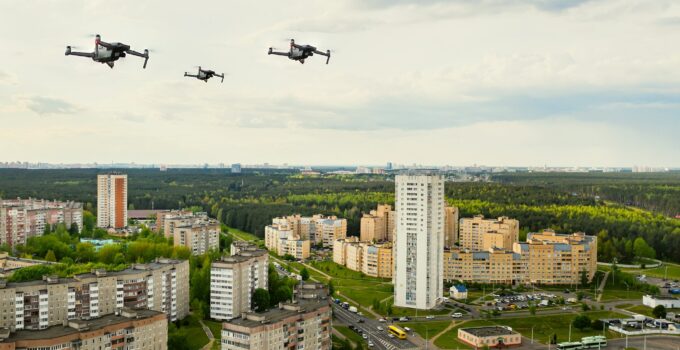Drones, also known as unmanned aerial vehicles (UAVs), are rapidly transforming various industries with their unique capabilities. In urban planning and logistics, drones are becoming indispensable tools due to their efficiency and versatility. This shift not only marks a significant technological leap but also showcases the potential for drones to streamline and enhance city planning and goods delivery.
In the realm of urban planning, drones provide city planners and architects with detailed aerial views that are often challenging to obtain through traditional methods. These UAVs can survey large areas quickly, offering real-time data that is crucial for making informed decisions about land use, infrastructure projects, and urban development. Drones equipped with advanced imaging technologies can create 3D models of buildings, track changes over time, and monitor the progress of construction sites. This capability allows for a more dynamic approach to designing urban spaces, ensuring that developments are both sustainable and well-integrated into the existing landscape.
Moreover, drones contribute to disaster management within cities by assessing damage from natural disasters such as floods or earthquakes. They can safely and quickly provide essential data that helps in planning recovery efforts and minimizing the impact on affected communities.
Transforming Logistics and Delivery Services
In logistics, drones are pioneering a shift towards more efficient and faster delivery services. Companies like Amazon and UPS are experimenting with drone delivery systems to transport goods directly to consumers’ doorsteps. Drones can navigate through urban environments using GPS and collision-avoidance systems, significantly reducing delivery times and bypassing ground traffic congestion. This method is not only faster but also more energy-efficient compared to traditional delivery vans and trucks.
The environmental impact of drone-based deliveries is another significant benefit. Drones typically use electric power, which contributes less to pollution and carbon emissions than gasoline-powered vehicles. This shift supports urban sustainability initiatives and helps cities reduce their environmental footprint.
Challenges and Considerations
Despite these advantages, the integration of drones into urban planning and logistics faces several challenges. Privacy concerns arise as drones often operate equipped with cameras and other sensors. Regulations must be carefully crafted to protect citizens’ privacy while still allowing drones to perform their functions effectively.
Furthermore, safety regulations are critical to ensuring that drones do not pose hazards to public safety, especially in densely populated urban areas. Air traffic control systems for drones are still in development, and managing the airspace when multiple drones are in operation is a complex task that requires sophisticated coordination and technology.
Looking Ahead
As drone technology continues to advance, its applications in urban planning and logistics are expected to expand. Future developments could include larger drones capable of carrying more substantial loads, further enhancing their utility in logistics. Additionally, as AI and machine learning technologies improve, drones will become more autonomous and capable of performing complex tasks with minimal human oversight.
In conclusion, drones offer transformative potential for urban planning and logistics. They provide critical data for city development, improve the efficiency of delivery services, and support sustainable urban environments. However, addressing privacy and safety concerns is essential for their successful integration into urban life. As we move forward, it will be crucial to balance these benefits and challenges, paving the way for drones to be a central component of modern cities.



